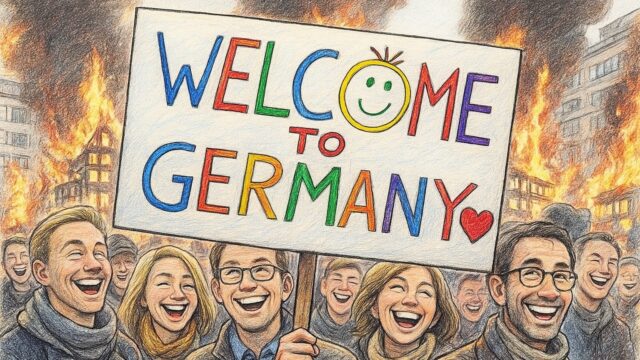The German Collapse Machine

The fiscal breaking point of mass immigration.
The cities stand trembling once more, as though their very stones had supped a poisoned draught beneath an ill-starred moon. And in that sickly lunar glow, their foundations quiver like stricken princes awaiting the stroke of fate. Germany’s local governments are drifting through the corridors of deficit dreams, €30 billion in projected city-level holes for 2025, widening like wounds from the €24 billion last year. The accountants whisper these numbers in backrooms, but the streets already feel it: the budgets breathing heavy, ready to collapse.
Germany, sleepwalker splice, drifts through Spengler’s night-cycle like a body on sedatives crawling through fluorescent ruin corridors, hands twitching over the cold geometry of dead-civilization architecture. Prussian backbone liquefies into bureaucratic jelly, dripping between municipal filing cabinets where ledgers sputter neon-death clicks, numbers sliding off the page like beetles fleeing a corpse-light. Essen–Dortmund–Berlin flash-frame across the feed: late-civilization organisms swollen with their own lifeblood, Faustian carcasses hooked to municipal pumps firing cash into hollow chambers: no destiny growth, only empty circulation loops.
The mayor of the former industrial giant Essen, Thomas Kufen, walks through his own city like a man pacing a battlefield trench. He says that “almost every German city is on the verge of bankruptcy,” and his voice falls down elevator shafts of old memories: cities once wealthy, once proud, now dissolving. In North Rhine–Westphalia, where coal once glowed hot in underground veins, only ten out of 396 cities can still balance their budgets, ten out of 396 actively breathing while the others choke on deficits that grow like vines around old town halls.
Bodies piling on bodies, costs stacking on costs. The causes show themselves like graffiti on abandoned highway underpasses: exploding welfare schemes dripping with numbers, integration programs devouring euros like teeth grinding through metal, housing and education and healthcare systems bent and buckling under mass immigration’s expanding scaffolding. Fifty billion euros a year now: the great fiscal monolith rising, swallowing fiscal space, eating the hours from municipal clocks.
Storm-breath of empire amputated. Integration quotas hiss in the ductwork. Administrative chatter pulses like insect wings behind the drywall. Overripe culture folds back into itself, soft collapsing hiss, a civilization turning its organs inward, swallowing its own historical marrow in slow motion, frame by frame. Spengler’s shadow tape rewinds: monstrous cities devouring their own future, pumping fiscal fluid into dead sockets, twitching in fluorescent static as the morphology twists, splits, mutates into paperwork fog. Germany drifting, spliced, dissolving under the white lights of its own terminal room.
In Essen, they dared to dream of a tiny €1.7 million surplus, a little flame cupped in two shaking hands. Today, the flame has died; the hands hold a €123 million crater instead. A hole so wide it changes the geometry of the city, bending streets inward, pulling lampposts into the dark.
Berlin—the distant emperor-city—offers its “rescue.” €28 million per year. A gesture like an eyelash falling. Enough for two schools, maybe; two institutions standing like skeletons in a tidal wave.
Kufen warns with the precision of a man watching a machine disintegrate. When the daycare centers fail, when the lights flicker and sink, when the streets break apart like old bones, the state ceases to work. The gears stop spinning. When that happens, he says, “democracy is in danger.” Not as a metaphor, but as a mechanical truth: a system deprived of oil, a system drowning in costs it cannot counter, a system bleeding out under pressures imported faster than they can be absorbed.
The city’s infrastructure: the roar of deficits, the growl of overburdened services, the slow fading of a model that once held, now broken. This is the anatomy of implosion. This is the logic of a society that opened too many doors too quickly, letting the weight of global flows settle onto its municipal body.
As the budgets collapse, the narrative becomes flesh: Germany’s cities are becoming a living autopsy, each number a scalpel, each deficit a gaping wound, each euro spent on unending immigration a reminder that no state can outrun its own arithmetic.
The lights flicker. The streets crack. And the diary of the republic, written in shifting deficits and exhausted bureaucrats, keeps repeating the same line: a country breaking under the cost of its own illusions.
In this hybrid night-cycle, the nation becomes a myth-body split by electric fractures, a civilization turning the knife inward, cutting new shapes from its own collapse while Spengler’s shadow stands behind the glass, watching the cities devour their future and muttering that this is how forms die: slowly, beautifully, with all the lights still on.
